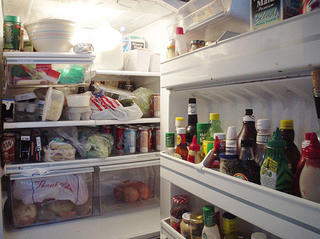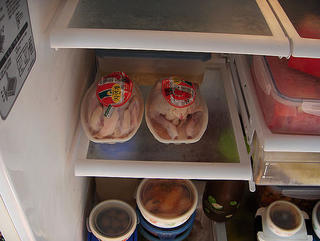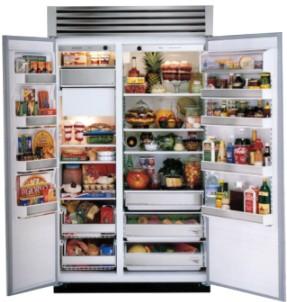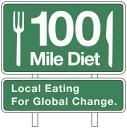Food Safety Corner: Refrigerator Storage
 You throw things in there, wherever there's room, and sadly, things can get forgotten WAAAY in the back, only to be rediscovered weeks later in the final stages of some science experiment.
You throw things in there, wherever there's room, and sadly, things can get forgotten WAAAY in the back, only to be rediscovered weeks later in the final stages of some science experiment.Of course, you don't need me to remind you to throw things out and keep that fridge clean. But did you ever think about the proper LOCATION for each and every item in the fridge?
First off: NEVER use the egg tray in the door of the fridge to store eggs. Eggs need to stay below 41° F (which means that the air temperature of the refrigerator needs to be 39° F or lower. Now, I don't know about you, but I open my fridge ALOT on any given day. Those door-swaddled eggs in their amusement park ride going back and forth all day are not going to stay cool enough, especially if you have kids or a husband (Like most men, I do some of my best thinking in front of an open fridge door).
 Bad Food Storage: NEVER store raw chicken over cooked food!
Bad Food Storage: NEVER store raw chicken over cooked food!
The other big food safety issue in a fridge is the vertical order of foods. Because of the danger of cross-contamination in a fridge, it's important to keep cooked and ready-to-eat food above raw food. Because this food won't go through a full cooking process to kill bacteria, raising it above the danger zone, any drip of raw food can contaminate the food and make it potentially dangerous to eat, even for a healthy person.
Here's the proper order of food storage in the refrigerator, from top to bottom:
Cooked and Ready-to-Eat Food
Whole Fish
Whole Meat
Ground Beef
Poultry
Granted, in most home refrigerators, there's simply not room to store everything on separate shelves, but it is essential to keep raw foods below cooked foods, and in closed, leakproof containers. When you bring meat, chicken or fish home from the market, never put it on the shelf of the fridge in it's market container. Always put it in a clean container, preferably one with a lid, to prevent any leakage. Using this method, you can place raw meats, chicken and fish NEXT to each other on the lowermost shelf, and know that they won't drip on each other.
Most domestic refrigerators have the produce drawer on the bottom. I would use this to store the raw meats, and place the vegetables in a container on the lower shelves. (Besides, when did the crisper drawer EVER keep anything crisp???)
Lastly, wrap or enclose all food properly to avoid cross-contamination and spoilage. Unwrapped food can pick up off odors from other foods in the fridge. Always use a clean spoon or knife to dip into jars to avoid introducing bacteria that can grow over time, even in a cold environment.
Some of these tips are just good common sense, but it bears reminding yourself of them every now and then. Even professional chefs need a little reminder once in a while. I recently took the ServSafe course to keep my certification current, so these rules are at the forefront of my consciousness.











0 Comments:
Post a Comment
<< Home